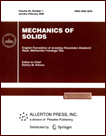 | | Mechanics of Solids
A Journal of Russian Academy of Sciences | | Founded
in January 1966
Issued 6 times a year
Print ISSN 0025-6544
Online ISSN 1934-7936 |
Archive of Issues
| Total articles in the database: | | 13362 |
| In Russian (Èçâ. ÐÀÍ. ÌÒÒ): | | 8178
|
| In English (Mech. Solids): | | 5184 |
|
| << Previous article | Volume 57, Issue 6 / 2022 | Next article >> |
| V.A. Babeshko, O.V. Evdokimova, O.M. Babeshko, and V.S. Evdokimov, "On One Mechanical Model of Self-Organization of Nanoparticles," Mech. Solids. 57 (6), 1338-1343 (2022) |
| Year |
2022 |
Volume |
57 |
Number |
6 |
Pages |
1338-1343 |
| DOI |
10.3103/S0025654422060164 |
| Title |
On One Mechanical Model of Self-Organization of Nanoparticles |
| Author(s) |
V.A. Babeshko (Southern Scientific Center, Russian Academy of Sciences, Rostov-on-Don, 344006 Russia; Kuban State University, Krasnodar, 350040 Russia, babeshko41@mail.ru)
O.V. Evdokimova (Southern Scientific Center, Russian Academy of Sciences, Rostov-on-Don, 344006 Russia)
O.M. Babeshko (Kuban State University, Krasnodar, 350040 Russia)
V.S. Evdokimov (Southern Scientific Center, Russian Academy of Sciences, Rostov-on-Don, 344006 Russia) |
| Abstract |
Based on the properties of block elements that imitate nanoparticles in contact with a multilayer base, a model of self-organization of such objects is built. It is assumed that the nanoparticles contact without friction with a deformable base that is in a state of vibration. To build a model in the article, for the first time, analytical relations are constructed that allow obtaining the parameters for the occurrence of high-frequency resonance for such a mechanical structure, or, what is the same, trap modes. Thanks to these relationships, based on the properties of the behavior of mechanical objects located on the surface of a deformable base under vibration conditions, a model of their self-organization is built. Self-organization consists in the desire, under certain mechanical and geometric parameters of a mechanical system, to unite surface objects. The constructed model allows its transfer to nanoparticles from multicomponent materials. |
| Keywords |
boundary value problems, nanoparticles, integral equations, high-frequency resonance, factorization, self-assembly |
| Received |
30 March 2022 | Revised |
03 April 2022 | Accepted |
04 April 2022 |
| Link to Fulltext |
|
| << Previous article | Volume 57, Issue 6 / 2022 | Next article >> |
|
 If you find a misprint on a webpage, please help us correct it promptly - just highlight and press Ctrl+Enter If you find a misprint on a webpage, please help us correct it promptly - just highlight and press Ctrl+Enter
|
|

 Russian
Russian  English
English